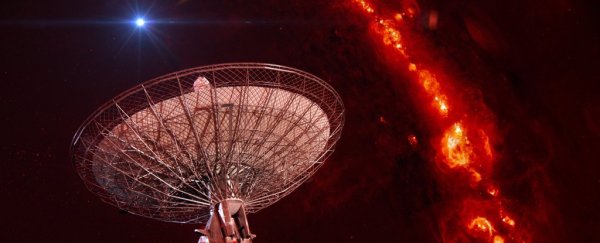Back in March, scientists detected 10 powerful bursts of radio signals coming from the same location in space. And now researchers have just picked up six more of the signals seemingly emanating from the same region, far beyond our Milky Way.
These fast radio bursts ( FRB) are some of the most elusive and explosive signals ever detected from space - they only last milliseconds, but in that short period of time, they generate as much energy as the Sun in an entire day. But despite how powerful they are, scientists still aren't sure what causes them.
Until the detection of the 10 repeating signals back in March, it was thought that the bursts were only ever one-off events, coming from random locations around space. And without a discernible pattern to them, researchers were left stumped as to what could be causing them.
The reason we're so in the dark about FRB isn't that they're that uncommon - researchers have estimated that there are around 2,000 of these FRBs firing across the Universe every single day - but that they're so incredibly short-lived that we struggle to detect them.
It was only in 2007 that we discovered FRB, and it wasn't until earlier this year that researchers were quick enough to see one happening in real time. Usually we have to study the events long after the fact.
But now that we've detected 16 of the signals all coming from the same place, scientists might finally begin to narrow down options for what could be causing the powerful bursts.
The first 10 radio bursts detected coming from this one region were first identified in March this year, but they actually occurred in May and June 2015.
Not only were these the first FRB ever detected outside our galaxy - the rest all appeared to originate in the Milky Way - but they also created a repeating pattern of signals unlike anything we'd seen before.
Six of the bursts were recorded arriving at the Arecibo radio telescope in Puerto Rico within just 10 minutes of each other, and then four more spread out signals were detected over the next month, all coming from the same place.
When the team looked back over the data, they also saw a FRB from 2012 that appeared to come from the same location, too, making a total of 11 FRB from the one spot, and indicating that there was something out there beyond the Milky Way that was regularly producing the extremely short and intense signals.
Now a team of researchers from McGill University in Canada has found six more of the mysterious signals coming from the same spot, which has become known as FRB 121102, after the first FRB detected there.
"We report on radio and X-ray observations of the only known repeating fast radio burst source, FRB 121102," the team wrote in The Astrophysical Journal.
"We have detected six additional radio bursts from this source: five with the Green Bank Telescope at 2 GHz, and one at 1.4 GHz with the Arecibo Observatory, for a total of 17 bursts from this source."
The team can't pinpoint the exact location of FRB 121102, but based on the specific way their lower frequencies are slowed, they can tell they came from a long way away, far beyond the Milky Way. And that gives us some pretty important clues about what could be causing the events.
Interestingly, it also contradicts the evidence we have on FRB coming from within our own galaxy.
Currently, the leading hypothesis for the source of the Milky Way's FRB is the cataclysmic collision of two neutron stars, which forms a black hole. The idea is that as this collision happens, huge amounts of short-lived radio energy are blasted out into space.
But the repeating nature of these distant signals, all coming from the same place, suggest that can't be the case - at least for these particular FRB.
Instead, the 17 radio bursts detected from FRB 121102 indicate that something less dramatic is going on - the most likely hypothesis at the moment for these outer-galactic FRB is that they're coming from an exotic object such as a young neutron star, that's rotating with enough power to regularly emit the extremely bright pulses.
The good news is that the two types of FRB don't necessarily contradict each other - a more likely prediction is that there's more than one type of FRB out there, both with different origins.
This is supported by the fact that the repeating FRB 121102 radio burst signals appear to be wider than the one-off events detected coming from within the galaxy.
But without more evidence to go on, researchers still can't say for sure what's going on.
"Whether FRB 121102 is a unique object in the currently known sample of FRBs, or all FRBs are capable of repeating, its characterisation is extremely important to understanding fast extragalactic radio transients," the team writes.
The race is now on to detect more of these FRB, either from within or outside our galaxy, and try to nail down once and for all where they're coming from. Because the strange events could also provide insight into the other mysteries happening within our Universe.
The research has been published at The Astrophysical Journal.
